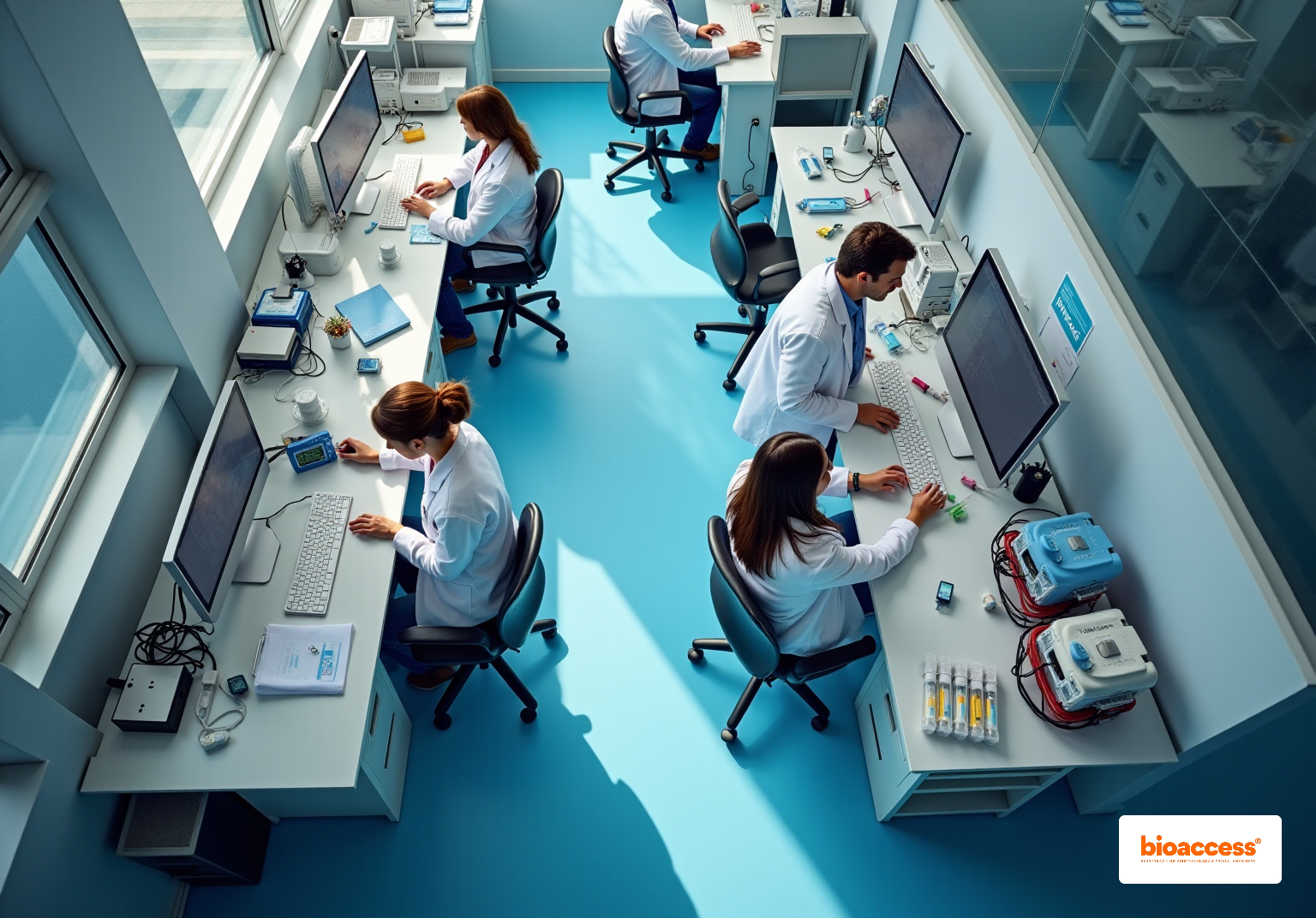


In the fast-evolving landscape of clinical research, the significance of medical equipment is paramount. These tools not only enhance patient safety but also streamline data collection, making them essential for achieving successful outcomes in trials. This article explores ten pivotal examples of medical equipment that are crucial for advancing healthcare solutions and play a vital role in overcoming common challenges faced in clinical research.
How can these devices transform the way researchers approach trials? What innovative technologies are on the horizon to further revolutionize this field? By addressing these questions, we can better understand the impact of medical equipment on clinical research and the future of healthcare.
bioaccess® excels in expediting clinical research for medical devices by leveraging the regulatory speed of Latin America, particularly Colombia. This region offers significant advantages, including cost efficiency, rapid regulatory processes, and high-quality healthcare. With a comprehensive suite of services, bioaccess® provides:
This strategic approach enables ethical approvals within 90-120 days and accelerates participant enrollment by 50% compared to conventional markets.
With over 20 years of expertise, bioaccess® empowers Medtech, Biopharma, and Radiopharma innovators to navigate complex regulatory environments effectively, ensuring timely breakthroughs in medical technology. The urgency of regulatory speed is underscored by the fact that around 80% of clinical studies fail to meet initial enrollment objectives, leading to substantial revenue losses-estimated at $8 million daily for drug discovery firms. Moreover, 95% of the Colombian population is covered by universal healthcare, providing a diverse patient pool for recruitment.
By harnessing these swift regulatory pathways and the robust healthcare framework in Colombia, bioaccess® not only enhances the likelihood of research success but also contributes to the advancement of healthcare solutions. Successful medical trials in Medtech that have utilized this regulatory speed further illustrate bioaccess®'s significant impact in the field. Are you ready to explore how bioaccess® can help you overcome your clinical research challenges?

Pulse oximeters are non-invasive devices that assess the oxygen saturation level in an individual's blood, playing a vital role in clinical settings such as preoperative evaluations and monitoring during anesthesia. Their capacity to deliver real-time information is essential for healthcare experts, allowing informed choices regarding care, particularly in critical situations where oxygen levels can change swiftly.
In preoperative evaluations, pulse oximeters assist in identifying individuals at risk of hypoxemia, which is crucial as hypoxemia can greatly affect surgical results. Research has demonstrated that individuals monitored with pulse oximetry during surgery encounter fewer hypoxemic events compared to those without monitoring, with incidence rates of 7.9% versus 0.4%, respectively. This statistic highlights the device's effectiveness in improving safety and outcomes for individuals.
In critical care, pulse oximeters are indispensable for continuous monitoring, allowing for timely interventions. For example, a study involving over 20,000 surgical individuals revealed that those monitored with pulse oximeters had a lower rate of ICU transfers for pulmonary complications, emphasizing their role in enhancing care management.
Moreover, during anesthesia, pulse oximeters are essential for monitoring oxygen saturation levels, helping anesthesiologists maintain oxygenation within physiological limits. Despite some studies suggesting no notable enhancement in results with routine monitoring, 94% of anesthesiologists still view pulse oximeters as beneficial in directing management. They can notify practitioners of possible hypoxemia, enabling faster treatment and potentially averting serious complications.
However, it is important to acknowledge the limitations of pulse oximeters. For instance, nearly 12% of Black individuals may experience an overestimation of oxygen saturation due to factors such as skin pigmentation and nail polish, which can affect the accuracy of readings. This highlights the need for clinicians to be aware of these discrepancies when interpreting pulse oximetry data.
Overall, the incorporation of pulse oximeters into healthcare practice not only improves monitoring of individuals but also aids in achieving better health results across various medical environments.

Blood glucose monitors play a crucial role for individuals managing diabetes, enabling real-time tracking of blood sugar levels. Among these, continuous glucose monitoring (CGM) systems are particularly noteworthy for their ability to provide comprehensive data throughout the day, significantly enhancing diabetes management. These devices not only allow individuals to continuously monitor their glucose levels but also empower healthcare providers to make informed treatment decisions based on real-time data.
In clinical research, CGMs are invaluable for assessing the efficacy of new diabetes treatments and devices. They enable researchers to gather extensive data on individual responses to interventions, capturing fluctuations in glucose levels that traditional monitoring methods might overlook. For instance, studies indicate that individuals using CGMs experience fewer instances of hypoglycemia and achieve lower A1C levels, which reflects improved glycemic control.
The integration of CGM metrics into clinical trials has been recognized as a game-changer. Experts note that the precision and usability of CGMs have significantly increased, making them essential tools for evaluating new glucose-lowering medications and strategies. Furthermore, the American Diabetes Association advocates for broader access to CGMs, emphasizing their potential to transform diabetes care and improve patient outcomes. With advancements in CGM technology, these systems are becoming the new standard in diabetes management, ensuring that individuals can maintain better control over their health.

Automated External Defibrillators (AEDs) are essential portable devices that analyze heart rhythms and deliver shocks to restore normal heart function during cardiac arrest. Their presence in medical environments is crucial, as rapid response can significantly enhance survival rates. Statistics reveal that immediate defibrillation with an AED can boost survival rates to between 50% and 74%, especially when used within two minutes of collapse, where survival rates can soar to as high as 70%.
Training healthcare professionals in AED use is not just beneficial; it is essential, particularly in trials involving high-risk populations. Effective training programs not only improve the likelihood of successful AED application but also instill confidence among staff, ensuring they are prepared to act decisively in emergencies. For instance, focused training initiatives have shown that survival rates can double when lay volunteers are equipped to use AEDs in high-risk public settings. This underscores the critical importance of thorough AED training in medical settings, where prompt action can lead to life-saving outcomes.

Home medical test kits serve a crucial role in empowering individuals to monitor their wellness conditions with convenience and privacy. These kits encompass tests for a range of conditions, including diabetes, cholesterol levels, and infectious diseases. In the realm of medical research, they significantly enhance data gathering and improve patient compliance with study protocols. By enabling participants to conduct tests at home and communicate results remotely, these kits streamline the research process and foster greater engagement.
As the Medtech landscape evolves, bioaccess emerges as a pivotal player in addressing key challenges faced in clinical research. The integration of home testing not only facilitates data collection but also enhances the overall patient experience. This innovative approach allows researchers to gather real-time data while ensuring that participants remain engaged and informed throughout the study.
Collaboration among stakeholders is essential for maximizing the potential of home medical test kits. By leveraging these tools, researchers can enhance the quality of their studies and drive meaningful outcomes. The next steps involve fostering partnerships that prioritize patient-centric solutions, ultimately leading to advancements in clinical research.
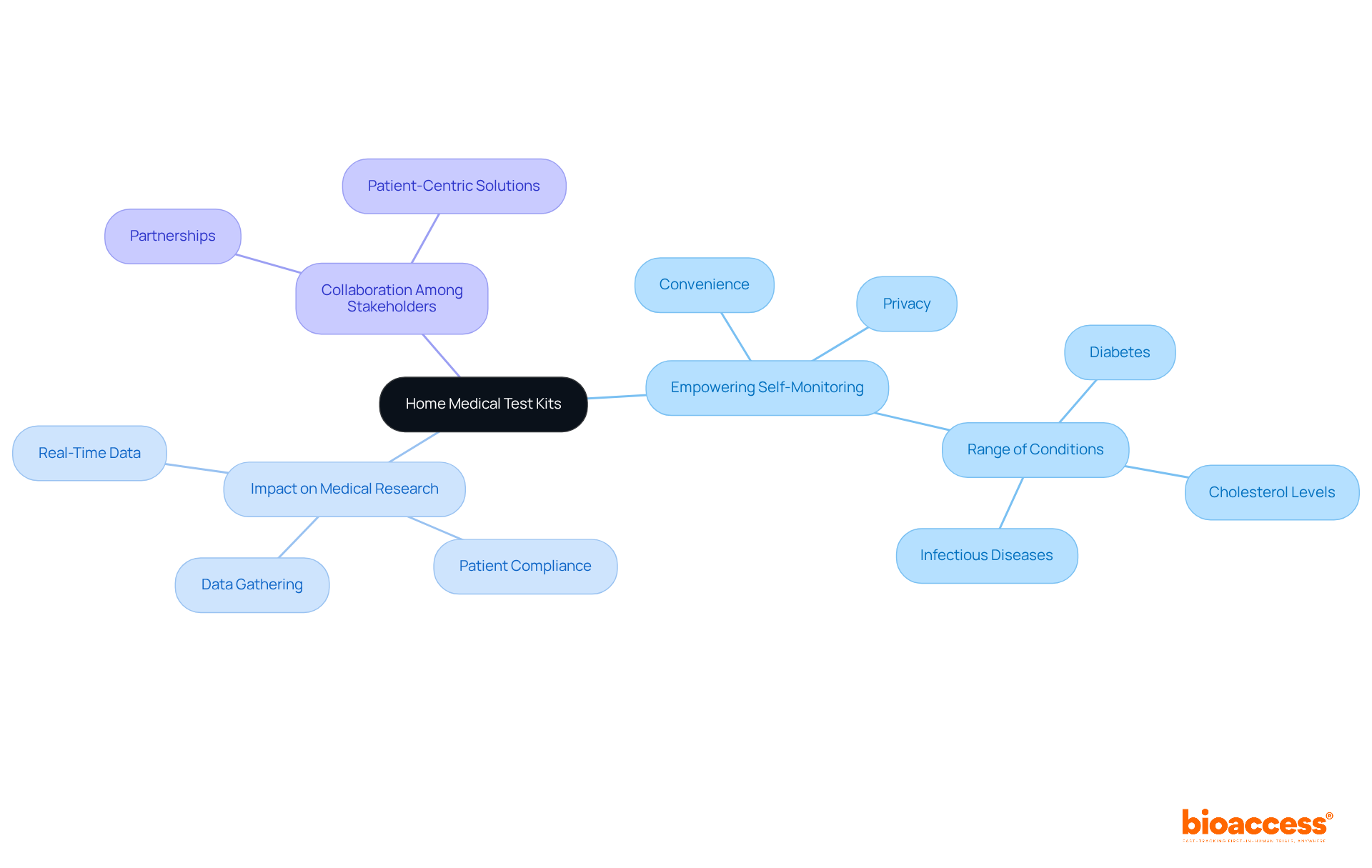
Menstrual tampons are not just comfort items; they are essential for managing menstrual well-being, particularly in research focused on women's health. Their importance extends beyond individual comfort; they significantly influence participant compliance and the overall outcomes of studies. Research shows that providing access to safe and effective menstrual products can greatly enhance participant comfort, which is vital for maintaining engagement in clinical trials. For instance, studies indicate that when participants feel supported in managing their menstrual health, compliance rates improve, leading to more reliable data collection and outcomes.
The Apple Women’s Health Study, which has gathered extensive data on menstrual well-being, underscores the importance of understanding menstrual product usage patterns and their implications for women. This research, involving over 60,000 participants, aims to destigmatize menstruation and improve well-being by offering insights into how menstrual products affect women's experiences during trials. Notably, 71,341 women were examined regarding the age at which girls begin menstruating, highlighting the broader context of menstrual well-being in research.
By prioritizing menstrual wellness management, researchers can foster a more inclusive and supportive environment, ultimately leading to better outcomes for women in medical research. Addressing challenges like period poverty, exacerbated by the taxation of menstrual hygiene products in many U.S. states, is crucial for ensuring equitable access to these essential supplies. As Dr. Michelle A. Williams aptly stated, 'Menstruation is a natural and normal part of life for half the population, but it remains surrounded by stigma in both science and society.' Therefore, medical researchers must actively engage in discussions about menstrual health and consider implementing strategies to effectively support participants in managing their menstrual health.
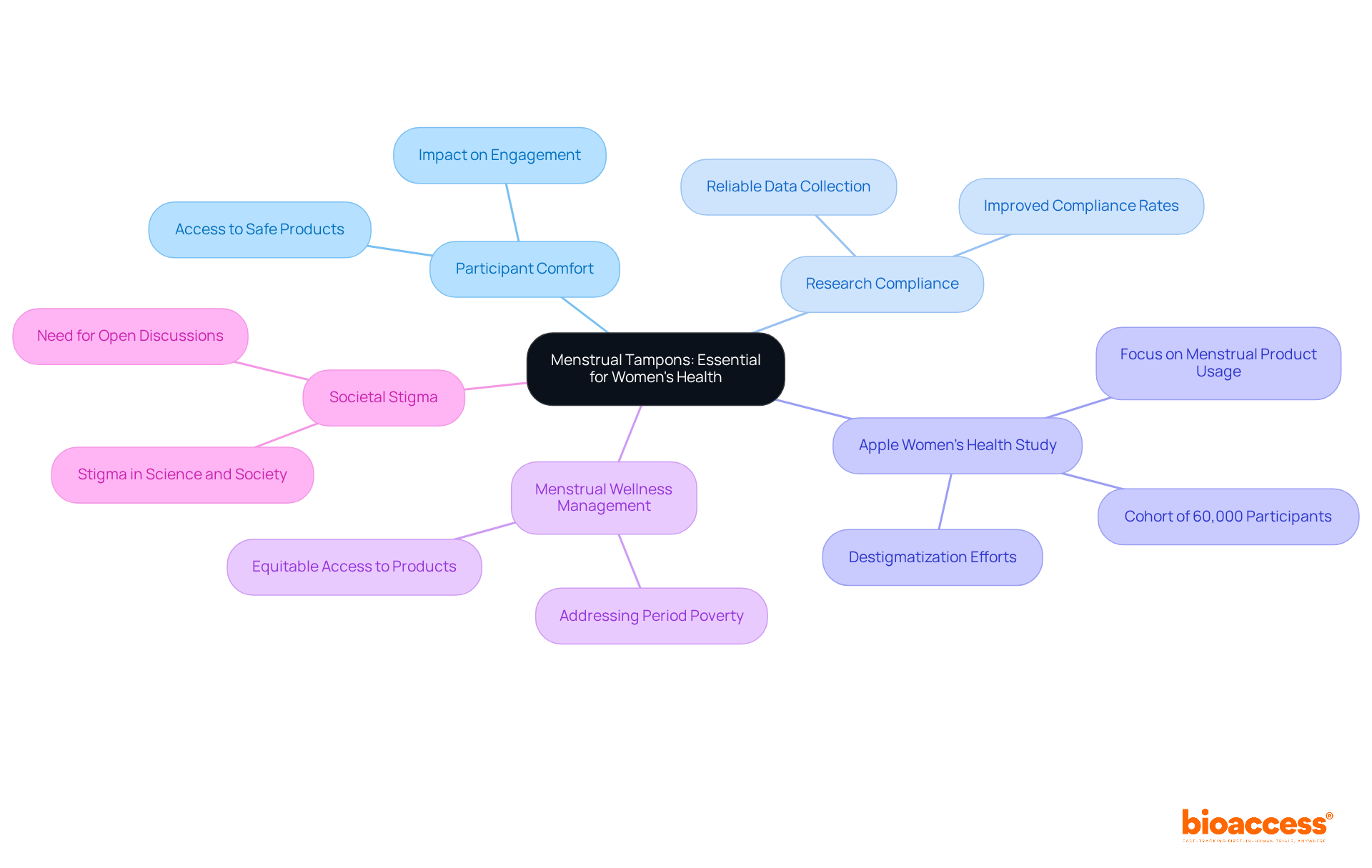
Lifting aids are essential tools that facilitate the secure and comfortable transfer of individuals with limited mobility, playing a significant role in clinical research environments. These devices alleviate the physical strain on both caregivers and those receiving care, enhancing safety and improving the overall quality of care during clinical trials. Notably, mobility assistance devices, such as lifts, have been shown to reduce injury rates among healthcare workers, fostering a safer environment for both staff and patients.
Studies indicate that organizations utilizing such equipment report better health and safety performance, as highlighted in systematic reviews on barriers and facilitators for the use of lifting devices. Furthermore, lifts contribute to a more dignified experience for those receiving care, allowing them to feel secure and respected throughout their journey. As healthcare evolves, incorporating mobility assistance devices remains crucial for ensuring effective care and safety in research trials.
To enhance the use of client lifts, clinical research directors should advocate for comprehensive training programs and organizational support. Addressing barriers such as equipment-related issues and cultural factors is vital for successful implementation. By prioritizing these initiatives, we can significantly improve the quality of care and safety in clinical research.

Bed rails serve as critical safety features positioned on the sides of beds, designed to prevent individuals from falling out. Their significance is particularly pronounced for elderly individuals and those facing mobility challenges. In the realm of clinical research, ensuring participant safety is paramount. Medical studies have shown that bed rails can significantly reduce fall-related injuries during experiments, underscoring their vital role in safeguarding participants.
As the Medtech landscape evolves, the integration of safety measures like bed rails becomes increasingly essential. These features not only protect individuals but also enhance the credibility of research outcomes. By addressing key challenges in participant safety, bed rails contribute to more reliable data collection and analysis.
In conclusion, the importance of bed rails in clinical research cannot be overstated. Their role in preventing falls is crucial for fostering a safe environment for participants. As we move forward, collaboration among researchers, healthcare providers, and Medtech innovators will be vital in ensuring the highest standards of safety and efficacy in clinical trials.

Pre-filled syringes play a crucial role in simplifying the medication administration process, offering a ready-to-use dosage that minimizes the risk of dosing errors and contamination. This makes them particularly valuable for research studies, where precision is paramount. Their convenience not only enhances patient compliance but also streamlines the overall research process, ensuring accurate data collection.
In the realm of extensive research management services, such as those provided by bioaccess™, the integration of pre-filled syringes aligns seamlessly with the rigorous standards required for feasibility studies, compliance reviews, and project management. This strategic approach not only boosts the efficiency of medical trials but also supports collaborative initiatives, like the partnership between bioaccess™ and Caribbean Health Group. Together, they aim to position Barranquilla as a premier destination for medical studies in Latin America, showcasing the potential of effective collaboration in advancing clinical research.
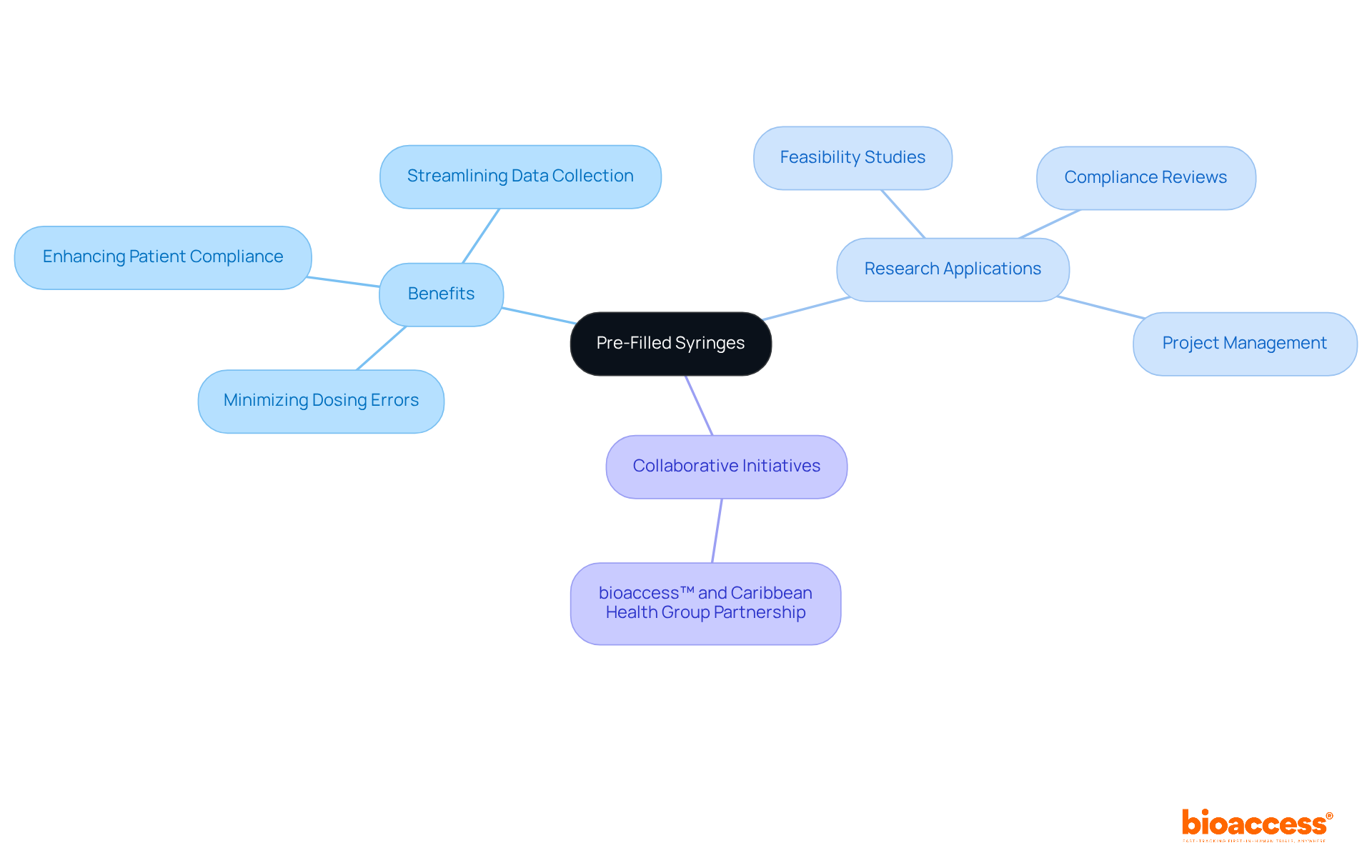
Robotic surgery represents a significant advancement in the medical field, utilizing robotic systems to assist surgeons in executing complex procedures with remarkable precision and control. This innovative technology has revolutionized various surgical disciplines, leading to shorter recovery times and improved patient outcomes. In the realm of medical research, robotic surgery plays a crucial role in evaluating new surgical techniques and devices, providing essential insights into their effectiveness and safety.
By leveraging bioaccess's extensive expertise in managing clinical trials, including Early-Feasibility Studies and First-In-Human Studies, researchers can thoroughly assess the impact of robotic surgery technologies on patient outcomes and surgical practices. This collaboration not only enhances the understanding of these technologies but also addresses key challenges within the Medtech landscape. As the demand for innovative surgical solutions grows, the role of bioaccess becomes increasingly vital in navigating this complex environment.
In summary, the integration of robotic surgery into clinical research underscores the importance of collaboration among stakeholders. By working together, we can drive advancements in surgical practices and improve patient care. The next steps involve engaging with bioaccess to explore how their expertise can support your clinical research initiatives.
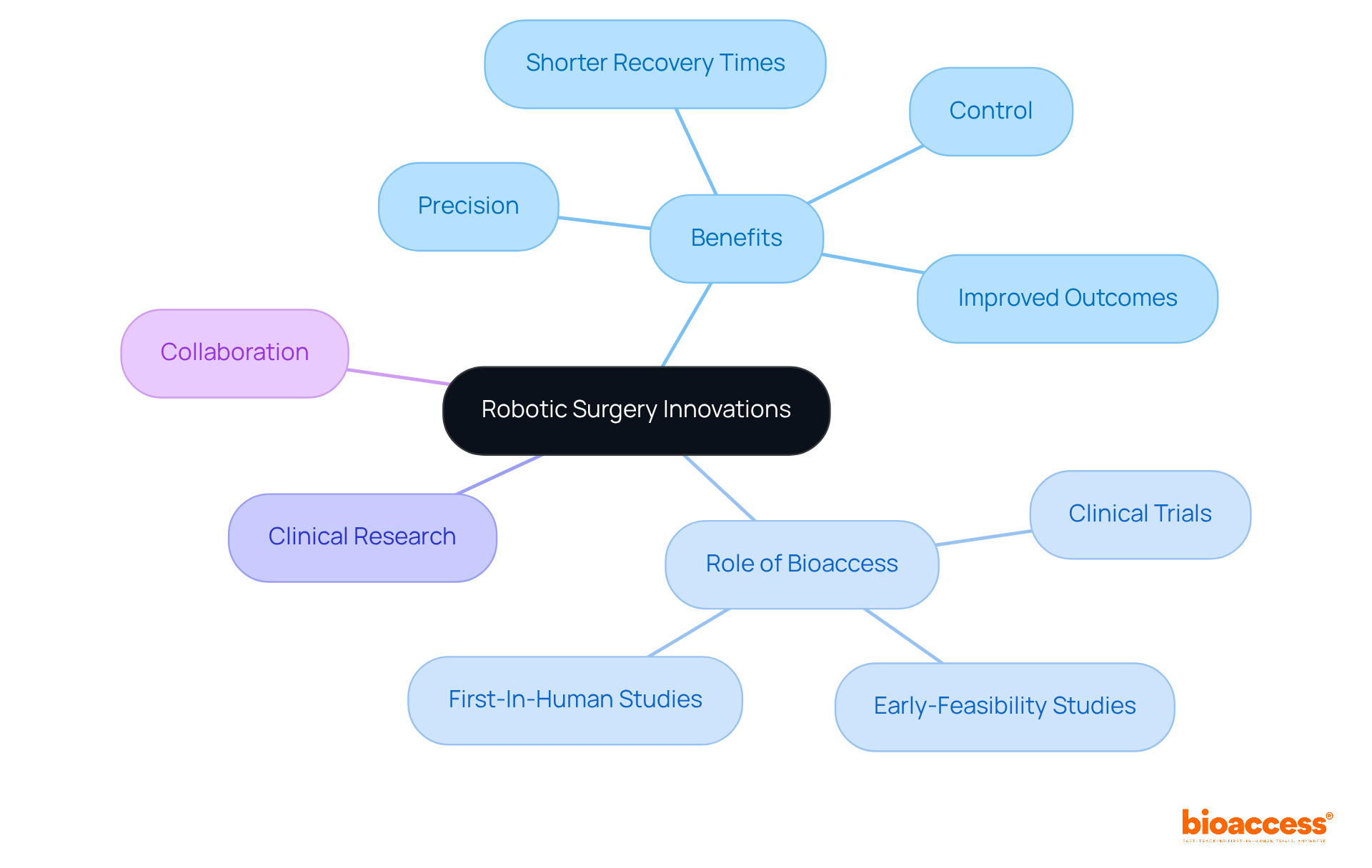
The landscape of clinical research is fundamentally linked to the effective use of medical equipment, which serves as a cornerstone for enhancing patient safety, improving outcomes, and ensuring the integrity of data collected during studies. This article has highlighted ten essential medical devices that not only facilitate research but also significantly contribute to the overall quality of healthcare delivery. From pulse oximeters and blood glucose monitors to automated external defibrillators and robotic surgery technologies, each piece of equipment plays a vital role in advancing clinical practices.
Key insights from the discussion reveal how these devices enhance patient monitoring, streamline medication administration, and support effective data collection in clinical trials. The strategic implementation of tools like home medical test kits and patient lifts fosters patient engagement and improves compliance and safety within research settings. Furthermore, addressing disparities, such as those related to menstrual health and the accuracy of pulse oximeters, underscores the need for inclusivity and awareness in clinical research.
As the medical field continues to evolve, embracing innovations in medical technology will be crucial for future advancements. Stakeholders in clinical research are encouraged to leverage these essential tools and foster collaborations that prioritize patient-centric solutions. By doing so, the potential for improved health outcomes and the advancement of medical knowledge can be significantly enhanced, ultimately leading to breakthroughs that benefit society as a whole.
What is bioaccess® and how does it support clinical research for medical devices?
bioaccess® accelerates clinical research for medical devices by utilizing the regulatory speed of Latin America, especially Colombia. It offers a comprehensive suite of services including feasibility studies, site selection, compliance assessments, testing setup, import permits, project management, and reporting.
What are the advantages of conducting clinical research in Colombia through bioaccess®?
The advantages include cost efficiency, rapid regulatory processes, high-quality healthcare, ethical approvals within 90-120 days, and a 50% faster participant enrollment compared to conventional markets.
How does bioaccess® contribute to the success of clinical trials?
With over 20 years of expertise, bioaccess® helps Medtech, Biopharma, and Radiopharma innovators navigate complex regulatory environments, enhancing the likelihood of research success and contributing to advancements in healthcare solutions.
What challenges do clinical studies face regarding participant enrollment?
Approximately 80% of clinical studies fail to meet initial enrollment objectives, which can lead to significant revenue losses estimated at $8 million daily for drug discovery firms.
What is the role of pulse oximeters in clinical settings?
Pulse oximeters are non-invasive devices that measure oxygen saturation levels in blood, crucial for preoperative evaluations, monitoring during anesthesia, and continuous monitoring in critical care settings.
How do pulse oximeters improve surgical outcomes?
Research shows that individuals monitored with pulse oximetry during surgery have fewer hypoxemic events, with incidence rates of 0.4% compared to 7.9% for those without monitoring, thus enhancing safety and outcomes.
What are the limitations of pulse oximeters?
Pulse oximeters may overestimate oxygen saturation in nearly 12% of Black individuals due to factors like skin pigmentation and nail polish, which can affect reading accuracy.
What is the significance of blood glucose monitors in diabetes management?
Blood glucose monitors, particularly continuous glucose monitoring (CGM) systems, allow individuals to track blood sugar levels in real-time, significantly improving diabetes management and enabling informed treatment decisions.
How do CGMs benefit clinical research for diabetes treatments?
CGMs provide extensive data on individual responses to new diabetes treatments, capturing glucose level fluctuations that traditional methods might miss, leading to improved glycemic control.
What is the American Diabetes Association's stance on CGMs?
The American Diabetes Association advocates for broader access to CGMs, recognizing their potential to transform diabetes care and improve patient outcomes.